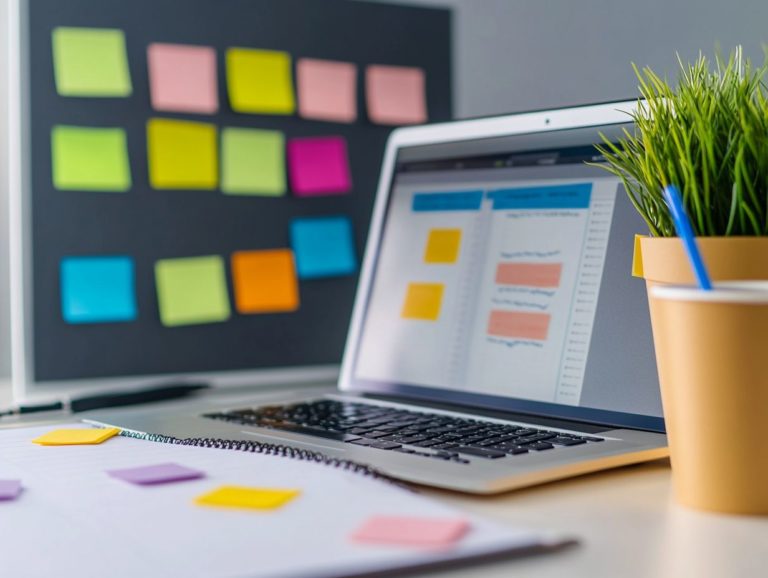how to improve team collaboration?
Effective team collaboration is vital for achieving success, both personally and for your organization. It boosts productivity, sparks innovation, and fosters a sense of community among team members.
However, various barriers can impede collaboration, ranging from communication breakdowns to unclear roles. This article explores why teamwork matters, highlights common obstacles, and provides practical strategies to enhance collaboration.
You’ll find valuable communication techniques, team-building activities, and the best tools to facilitate teamwork.
With insights on measuring success, you’ll learn how to create a more cohesive and efficient team.
Contents
- Key Takeaways:
- The Importance of Team Collaboration
- Barriers to Effective Team Collaboration
- Strategies for Improving Team Collaboration
- Tools and Technologies for Collaboration
- Measuring and Evaluating Team Collaboration
- Frequently Asked Questions
- How can communication be improved to enhance team collaboration?
- What are some strategies for building trust and rapport within a team?
- How does leadership promote effective team collaboration?
- How can conflicts be resolved to improve team collaboration?
- What are some effective ways to delegate tasks and responsibilities among team members?
- How important is feedback in enhancing team collaboration?
Key Takeaways:

Effective team collaboration benefits individuals and organizations, including increased productivity, creativity, and satisfaction. Identifying and addressing common barriers, such as lack of communication and unclear roles, greatly improves collaboration. Implementing strategies like effective communication techniques, team-building activities, and clear role definitions can enhance teamwork.
The Importance of Team Collaboration
Team collaboration is crucial for building successful businesses. It creates a supportive environment where colleagues work together toward a shared goal.
In today’s fast-paced digital landscape, effective teamwork not only boosts your motivation but also elevates productivity and sparks innovation.
Acknowledging collaboration’s importance is key to nurturing a culture that drives high performance and paves the way for success within any organization.
Benefits for Individuals and Organizations
The benefits of effective collaboration resonate deeply, fostering teams that encourage creativity and innovation while allowing for easy sharing of ideas.
This dynamic environment boosts job satisfaction and cultivates a culture that celebrates uniqueness and diverse perspectives.
Organizations like the Royal Bank of Scotland and Standard Chartered Bank exemplify the transformative power of teamwork. By using advanced performance tools, they promote open communication and brainstorming sessions, resulting in groundbreaking ideas and solutions.
As teamwork flourishes, engagement increases, leading to higher morale and a stronger sense of belonging. Ultimately, this benefits the bottom line and champions the spirit of teamwork.
Barriers to Effective Team Collaboration
Despite clear advantages, you may face barriers to effective team collaboration that hinder growth and performance.
Common challenges include a lack of transparency in communication, resistance to change, and insufficient performance tools, all of which can prevent your employees from working together effectively.
Identifying and Addressing Common Obstacles
Identifying and resolving obstacles to collaboration is essential for creating a productive team environment. Poor communication and unclear role definitions can derail collaborative efforts.
To tackle these challenges, prioritize clear and open dialogue among team members. You can lead by example with regular check-ins where everyone feels comfortable sharing concerns and suggestions.
Investing in tools like:
- Slack: A messaging tool that helps teams communicate in real-time,
- Dropbox: A platform for easy file sharing,
- Loom: A tool for quick video updates.
These tools enhance clarity and foster a culture of transparency. By utilizing these resources, you can create an atmosphere that encourages effective teamwork and minimizes misunderstandings.
Strategies for Improving Team Collaboration

Now is the time to implement strategies that supercharge team collaboration and drive success! By prioritizing collaboration, you create a space where individuals can work together seamlessly, ultimately benefiting the entire team.
Start improving your team collaboration today!
Communication Techniques
Effective communication techniques are essential for cultivating transparency, ensuring that your team is aligned and contributing to a cohesive digital workplace.
When you collaborate effectively, it boosts morale and enhances productivity, creating an environment where ideas can truly flourish.
Techniques like daily stand-ups and regular feedback loops are crucial in this journey. They enable continuous dialogue and allow for swift course corrections.
By using performance tools, teams can measure progress and align goals more efficiently.
Platforms such as Flock and Samepage make these interactions seamless, offering intuitive spaces for discussions, file sharing, and task management.
This integration of communication tools significantly enhances collaboration, ultimately leading to more successful project outcomes.
Team Building Activities
Team building activities are crucial for cultivating a supportive environment that fosters creativity and collaboration among team members.
These experiences help you bond with your colleagues and create meaningful opportunities to celebrate the essence of teamwork.
Get everyone involved in workshops where team members can share their knowledge on various topics. This can spark intellectual engagement and enhance essential skills.
Activities like team sports or volunteer projects can also break down barriers and nurture a sense of community.
Using insights from tools like the Nectar survey reveals what truly motivates teams, enabling leaders to craft experiences that resonate deeply. This approach maximizes participation and commitment to shared goals.
Establishing Clear Roles and Responsibilities
Establishing clear roles and responsibilities is essential for creating collaborative teams that understand their contributions toward a shared goal.
This clarity cultivates a culture of accountability, which is vital in today s fast-paced work environment.
Successful businesses often use strategic frameworks, such as the RACI (Responsible, Accountable, Consulted, Informed) matrix, a tool that clarifies who is responsible for what in a project.
By implementing these collaboration strategies, everyone knows their specific duties, resulting in more efficient workflows and improved team synergy.
When roles are well-defined, it fosters trust among team members, paving the way for innovative solutions and enduring success.
Tools and Technologies for Collaboration
In today s digital workplace, using advanced collaboration software and performance tools is crucial for elevating workplace collaboration and facilitating seamless communication among team members.
Embracing these technologies streamlines interactions and fosters a more cohesive environment where ideas can flourish and productivity can soar.
Online Platforms and Software

Numerous online platforms and collaboration software have emerged to help you navigate the complexities of effective teamwork.
Among these, Dropbox stands out with its seamless file-sharing capabilities, enabling effortless storage, organization, and access to documents within a centralized cloud storage system.
Slack provides an intuitive messaging platform that promotes real-time communication, integrating various tools and boosting cooperative efforts through channels dedicated to specific projects or themes.
HubSpot acts as an all-in-one marketing, sales, and service platform, streamlining workflows and facilitating better communication between departments.
By leveraging these tools, teams can boost productivity and foster a more connected and engaged work environment.
Measuring and Evaluating Team Collaboration
Measuring and evaluating team collaboration is crucial for understanding its effectiveness and pinpointing areas for improvement.
This process enables organizations to refine their performance tools, ultimately leading to enhanced outcomes.
Key Metrics for Success
Identifying key metrics for success in collaboration helps you track progress and evaluate the effectiveness of your collaborative efforts.
By measuring specific indicators, such as how involved employees feel in their work and how often projects are finished on time, you gain valuable insights into the evolving collaborative culture within your teams.
A higher level of employee motivation often correlates with enhanced teamwork and productivity, as studies from the Harvard Business Review suggest.
Analyzing communication between different departments can reveal synergy, while recognizing team accomplishments cultivates a greater sense of unity and drive.
These metrics shine a light on both your growth areas and your amazing successes!
Frequently Asked Questions
How can communication be improved to enhance team collaboration?
Communication is key to improving team collaboration. Encourage open and honest dialogue, establish clear expectations, and utilize tools like project management software or team chat platforms to facilitate conversations, especially by maximizing team output with collaboration tools.
What are some strategies for building trust and rapport within a team?

Building trust and rapport can significantly enhance team collaboration. Encourage team-building activities, promote transparency and inclusivity, and address conflicts immediately to foster a positive team dynamic.
How does leadership promote effective team collaboration?
Leaders play a crucial role in fostering team collaboration. They should lead by example, set clear goals, and encourage open communication among team members.
How can conflicts be resolved to improve team collaboration?
Conflicts are inevitable but can hinder collaboration. Encourage open dialogue, actively listen to all perspectives, and find compromises that work for everyone involved.
What are some effective ways to delegate tasks and responsibilities among team members?
Delegating tasks effectively can improve team collaboration. Clearly define roles and responsibilities, consider each team member’s strengths and weaknesses, and provide support when needed.
How important is feedback in enhancing team collaboration?
Feedback is crucial for improving team collaboration. Encourage regular, positive, and constructive feedback from team members to enhance processes, communication, and overall performance.
Have more questions? We’d love to hear from you!






